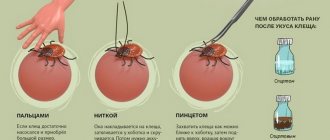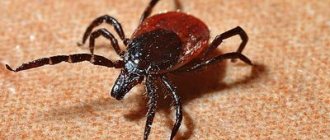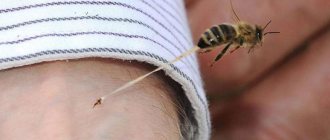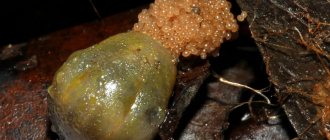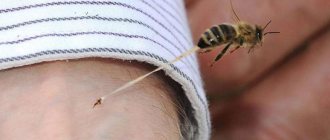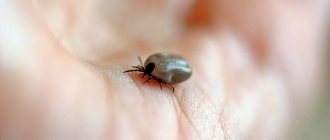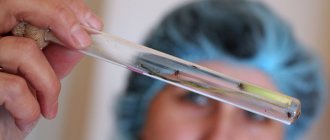Ticks appear at the end of March and disappear in October with the onset of persistent cold weather. They live in grass and lower branches of bushes. The location of the victim is determined by smell. They crawl onto clothes made of grass or fall from bush branches. It takes a few minutes to get used to it, choose the most favorable place, and attach itself. One of the most asked questions is whether a tick can fall off on its own.
How a tick bites and where
The pest looks around for a while, looking for a favorable place to bite. This process takes approximately half an hour. It penetrates into places where the skin is thin and blood vessels are located closer to the surface.
- armpits;
- groin;
- stomach;
- small of the back;
- breast;
- behind the ears;
- neck;
- scalp.
On a note!
The tick bite itself is painless. The head penetrates the skin, the abdomen remains outside. A hungry tick is no more than 3 mm in size, so it often goes unnoticed. During feeding, the abdomen increases in size to 10 mm in diameter or more.
Can a parasite burst?
Despite the fact that in the process of eating blood, the tick swells to enormous sizes, it cannot burst. The integrity of the insect can only be damaged by physical force.
When removing the parasite yourself, you should be careful not to damage it. It is extremely difficult to pull out an insect piece by piece. If part of the pest remains in the body, suppuration will begin in this place.
Is it possible to miss a tick bite?
The arachnid bites with powerful jaws, but since they are miniature, the bite itself is not felt. The head quickly penetrates the skin, the parasite slowly sucks blood. Initially, the size of the tick is so small that even with an accidental touch you may not notice its existence.
After some time, the abdomen enlarges, becomes convex, oval, sticks out on the surface of the skin, resembling a wart or papilloma. If the parasite has attached itself to the back of the head, back, or groin, you may not notice it.
The body reacts to a tick bite in different ways. Depends on the sensitivity of the skin, the strength of the immune system, and the tendency to allergies. At the site of the bite appears:
- swelling;
- slight redness;
- slight itching;
- in the center, at the site where the parasite is attached, there is a dark spot with dried blood.
The tick bite
of the epidermis recovers on its own within a few days. With such a reaction of the body, you may not notice the bite and not know about its existence. If you have an allergy, the symptoms are more pronounced:
- swelling;
- large-scale redness;
- inflammation;
- incessant itching;
- additional rash.
Manifestations of allergies cannot be ignored, but you may not know the cause if the parasite is no longer present at the scene of the “crime”.
How to recognize that an infection has occurred?
Another danger of tick parasitism on the human body is that at the initial stage it is impossible to determine whether the parasite is infected with an infection. Signs appear after a few weeks (sometimes after 10 days), the speed of onset of symptoms depends on the sensitivity of the body, as well as the person’s immunity.
The parasite's saliva or external surfaces often contain harmful microorganisms. However, they are not present in all individuals, but only in those that have previously bitten infected animals and birds. If such a tick attacks a person, then we can assume the development of dangerous diseases, since the probability of this is quite high. For an infection to manifest itself, it takes time to develop and spread in the body.
Such a period
called incubation: infection has already occurred, but symptoms have not yet appeared.
Signs suggesting the development of infection:
- erythema, it can be quite large - up to 60 cm;
- temperature increase (and this happens sharply and to extreme values): 39...40°C;
- itching – the intensity of this manifestation can be high, itching is difficult to bear, resulting in scratching;
- swelling is a natural reaction of the human body to a developing inflammatory process.
Erythema on the skin after a tick bite
How long does a tick stay on the body?
Females and males attack humans. Females are more voracious, since they need blood to form new offspring. The male can bite and fall off in a matter of minutes. A few milliliters of blood is enough to saturate it. Further stay on the body is advisable only if the female remains there. In other situations, the male unnoticedly unhooks and climbs out.
On a note!
The female can also bite and fall off, but this takes longer. To saturate females, up to 20 ml of blood is required. The parasite replenishes these reserves gradually. The time spent on the human body depends on the initial degree of saturation. If the female was not too hungry, she latches on for only a few minutes. In other cases it lasts up to 3 days.
When the tick falls off on its own, it means that it has completely quenched its thirst, and further stay on the body loses its meaning. If the attempt is unsuccessful, the parasite bites a second time and starts eating.
Danger to humans
These blood-sucking creatures pose a great threat to humans, as they can infect dangerous diseases. In this case, it does not matter at all whether it is found on the body, or whether it drank blood and fell off on its own; it is its bite that is dangerous. Therefore, it is very important to contact medical institutions when it is detected.
If you manage to save the insect, you can submit it for analysis, which will show whether this individual is infected. If you remove it from the body yourself, then you need to put it in a glass container along with a piece of damp cloth, which will not allow it to dry out. Analyzes are carried out with live insects, which allows you to obtain accurate results. If the parasite is dead, burst, or there is only a fragment of it, then research can be carried out, but the result will not be accurate.
In cases where you have not noticed the tick itself on your body, then symptoms appear, consult a doctor immediately. These parasites can transmit diseases such as encephalitis and Lyme disease.
Lyme disease
This disease is manifested by such symptoms as fever, headache, body aches, weakness, and a cough and runny nose may also appear. These symptoms are similar to a cold or even the flu, so a person may not think about having a dangerous infectious disease. The main sign that you definitely need to pay attention to is the appearance of a large red spot on the body, which has a clear outline.
This disease affects the nervous and lymphatic systems. It is very important to start treatment at an early stage, since brain activity suffers, memory may deteriorate, and disturbances in thinking processes occur. The facial nerves are also affected as they are damaged.
If the correct treatment is applied, the disease can be completely cured. In situations where treatment is not applied, complications occur, which in severe forms are not always amenable to treatment.
Tick-borne encephalitis
This disease is very dangerous with complications. Encephalitis manifests itself with the same symptoms as the previous illness, only there is no reaction in the form of a circle on the skin.
If left untreated, the nervous system is affected; this process can occur as early as a week after infection. The person experiences severe headaches and epileptic attacks may occur. Next, internal organs are damaged, the liver, kidneys, etc. are destroyed.
Regarding children, the disease poses an even greater danger for them, since children cannot correctly describe their condition and talk about their feelings, which for parents does not allow them to create a complete picture and correctly respond to the situation. It is very important after each walk in nature to pay maximum attention to examinations and, at the slightest suspicion, consult a doctor.
In addition to the above diseases, ticks also carry other dangerous infections, which include typhoid, ehrlichiosis, fever, tularemia, etc. The diseases are treatable, the main thing is to seek medical help in time, then you can avoid serious consequences.
Hemorrhagic fever
By the name of this pathological condition, one can understand that its main symptom is a sharp increase in temperature to extreme values (39...40°C). In addition, signs characteristic of viral diseases appear. When a blood test is performed, leukopenia and thrombocytopenia are often diagnosed based on changes in its composition. One of the main signs of hemorrhagic fever is a violation of the integrity of the walls of blood vessels.
As a result,
their permeability increases, which contributes to redness of the outer integument.
Hemorrhagic fever after a tick bite
Viral infections
Tick-borne encephalitis is one of the dangerous viral infections that affects the peripheral and central nervous systems.
At the onset of the disease, chills and fever begin, then damage to the meninges, fever, vomiting, drop in blood pressure, and arterial hypertension occur. Possible death.
Infection with encephalitis occurs when the parasite sucks blood . The male tick sucks blood for a short time - several hours. But the female stays on the skin for many days. The incubation period of the virus lasts 1-2 weeks. During this period, the affected person may not experience any symptoms.
Next, a fever appears, which lasts acutely and is characterized by a very high temperature - up to 40 degrees . Severe headaches, dizziness, hallucinations, and muscle pain appear. Vomiting and nausea are possible. Confusion and deafness often occur. Complications of the disease include paralysis of muscles and nerves.
The disease is treated by administering ready-made antibodies, which are obtained from the blood masses of donors. In the first hours after the bite, it is especially important to administer immunoglobulin. Treatment with antiviral drugs, ribonuclease and interferon is also used.
Ixodid tick-borne borreliosis (Lyme disease) is transmitted by ixodid ticks using saliva. The incubation period of the disease is 7-14 days.
Early symptoms of infections are fever, inflammation of joint tissues, erythema migrans, and elevated temperature. The disease affects the organs of vision, heart, blood vessels, and central nervous system. The course and outcome of the disease depends on timely access to doctors. Chronic borreliosis is especially difficult to treat.
Treatment includes:
- supportive and anti-inflammatory therapy;
- taking antibiotics;
- consumption of vitamins;
- prescription of immunomodulators.
Medicines are prescribed that relieve intoxication and regulate the functioning of internal organs.
Tick-borne typhus is another disease transmitted by insects. The disease is especially often caused by taiga ticks in Siberian regions.
The incubation period of the disease is 4-5 days. Further, the disease manifests itself as muscle pain, fever, and tissue necrosis. The disease has a favorable prognosis. In most cases, Tetracycline and antiviral drugs are prescribed for treatment.
Microbial infections
Ehrlichiosis is an infection transmitted through the saliva of a parasite. A focal infection is caused when an insect attaches itself to a person.
If you find a mark from a tick bite, you must go to the hospital. When bitten, Ehrlichia penetrates the bloodstream and causes the development of an inflammatory process.
Monocytic ehrlichiosis is characterized by:
- abdominal pain;
- damage to the central nervous system;
- nausea;
- vomit;
- hyperesthesia;
- chills;
- catarrhal symptoms;
- feverish condition.
In case of illness, it is important to periodically check the blood picture - complications such as leukopenia, anemia, lymphocytopenia are possible . Whole blood and serum are taken for research. Treatment of the disease is prescribed even before laboratory results are obtained. The main drug in therapy is Doxycycline.
Ixodid ticks also cause granulocytic anaplasmosis. The disease is caused by an intracellular parasite carried by ticks. Together with the insect's saliva, anaplasmas enter the bloodstream and infect neutrophils.
As a result, various inflammations develop in the internal organs. The acute course of the disease is characterized by severe kidney damage - proteinuria develops. Treatment comes down to eliminating the pathogen and symptoms of the disease.
Rickettsial infections
Mountain fever is an infection caused by an Ixodid tick bite. The causative agent is rickettsia bacteria. The disease is expressed in general intoxication and fever.
Special signs of the disease are:
- microinfarction;
- pathological changes in blood vessels;
- necrosis of cellular endothelium;
- blood clot formation;
- inflammatory process of arterioles.
As the infection progresses, an extensive measles rash appears. In the severe stage, the disease takes on a hemorrhagic form. The disease is accompanied by an inflammatory process in the kidneys and interstitial myocarditis.
Rocky Mountain fever is the most severe rickettsial infection.
At the onset of the disease, the following begins:
- nosebleeds;
- lymph nodes become inflamed;
- joints are affected.
There is headache and prostration of consciousness. A characteristic sign of the disease is damage to the central nervous system. Pneumonia and gangrene of the extremities may occur.
The treatment of mountain fever involves antibiotic therapy and drug relief of hemorrhagic changes and thrombosis.
Medications to normalize the temperature and antibiotics Doxycycline, Levomycetin, Tetracycline are prescribed. Heparin is administered intravenously using a dropper. Treatment is carried out in a hospital inpatient unit.
Coxiellosis (Q fever) is a rickettsial disease caused by tick bites. The causative agent of the disease can be found in dry tick feces. A person becomes infected with a fever from a tick bite. The incubation period lasts up to 17-19 days.
Then the symptoms begin:
- muscle pain;
- wheezing in the bronchi;
- bradycardia;
- heat;
- headache;
- eye pain.
Treatment boils down to eliminating the pathogen with antiviral therapy and eliminating symptoms. Recovery with proper treatment occurs after 2-4 weeks. However, in some cases, a relapse of the disease is possible.
Protozoal infection
The tick is a carrier of protozoa, bacteria, and viruses, so the appearance of a protozoal infection after a bite is not uncommon. The intestinal form of infection affects the entire gastrointestinal tract. Very often, with a mild course of the disease, a person does not pay attention to periodic attacks of loose stools and abdominal pain. No intoxication or increase in temperature is observed.
In severe cases, the stool may contain blood streaks and be jelly-like. Extraintestinal forms of the disease are manifested by damage to the liver, lungs, and brain.
Treatment of the pathology includes the use of Doxycycline, antibiotics, Etoftamide, Chloroquine. The prescription of medications depends on the form of the disease.
To prevent diseases, it is important to follow preventive measures when visiting the park area. There is a wide variety of parasite species in nature. It is important not to leave exposed areas of the body without clothing when walking in the forest, and also, if possible, apply insect repellents to the body.
Can a tick bite and crawl away?
This situation happens if the arachnid has attached itself to the skin and remained unnoticed until it was completely saturated. The pest carefully extends its head and falls away. Under natural conditions, the female lays eggs on the surface of the soil. At home, if this happens, the offspring will not be able to be born. The likelihood that a tick can bite again and leave remains minimal.
Tick bite
When the tick has sucked and fallen off, redness, slight swelling, and slight itching remain at the site of the bite. The skin is restored within a few days. In the presence of an allergic reaction, special treatment is required - the use of local, systemic antihistamines, antiallergic drugs. If the tick has been infected, manifestations of the disease appear after 14-60 days.
A reliable way to kill a tick is to burn it.
Ticks removed from cats and dogs are not sent to the laboratory, but simply destroyed so that they do not go in search of a new victim and do not leave offspring.
You should not drown ticks; they do not die in water. If you decide to fill it with something, it is better to use alcohol or vinegar.
There are several ways to kill a tick; the surest option is to burn it. To do this, you need to squeeze it with tweezers and set it on fire with a match or lighter, or throw it into the fire.
If you notice a parasite on your body already in the apartment, you can kill it in the microwave. The insect is placed in a closed container and heated in it at maximum power. After the procedure, the container is thoroughly washed.
If a tick is found on clothing, it should be washed with powder and placed in the dryer. Already in it, at a high temperature, the parasite will die.
And the simplest method is to put the tick in a dry container with a tight-fitting lid and forget about it; the parasite will die from dehydration and starvation.
Consequences of bites from infected ticks
Even if the tick was able to get out on its own and went unnoticed, the virus, when it enters the blood, begins to develop and progress. The first symptoms appear within 1-2 months. Depends on the strength of the immune system and the type of disease. The infection is transmitted through saliva and blood.
- Tick-borne encephalitis. The virus enters the human body through the blood. If the infected creature gets enough and falls off, infection will not occur. If it is accidentally injured or removed incorrectly, its blood enters the wound and the virus begins to spread. Affects the spinal cord, brain, and nervous system. Leads to disability, paralysis, madness, death.
- Lyme disease or borreliosis. The infection is transmitted through saliva. Affects the central nervous system, heart, joints. If not treated in a timely manner, complications may lead to disability and death.
- Ehrlichiosis. Less common disease. The virus leads to respiratory and kidney failure.
Diseases from ticks
Other diseases transmitted through a tick bite are typhoid, anaplasmosis, babesiosis, tularemia, hemorrhagic fever.
Important!
The first signs of the disease resemble the flu. Fever, nausea, vomiting, muscle aches, weakness, headache, increased body temperature, etc. appear. The condition returns to normal after 5-7 days, but recovery does not occur. Within a month, the disease makes itself felt again, but with renewed vigor and different symptoms. Treatment is carried out in a hospital.
What you need to know about ticks
Ticks live on tree branches and grass. Most of these insects feed on various plants and fungi. And for some of them, human or animal blood became food. It is these ticks that pose a danger because they can easily carry dangerous viruses.
Among the infections transmitted by the parasite, the greatest danger is tick-borne encephalitis. The disease causes damage to the central nervous system and leads to persistent paresis and dementia. In addition, the tick can serve as a carrier of borreliosis, tularemia, and hemorrhagic fever.
Prevention means
You can prevent a tick bite by following basic rules of behavior:
- Wear thick clothing with cuffs, elastic bands, socks, and hats. If the pest does not reach the skin, it falls from the clothing back to the ground and does not bite.
- Use tick repellents. They use aerosols and sprays - Gardex, Taiga, Raptor, Raid, Clean House, etc. The action lasts for a maximum of 2 hours, then you need to repeat the treatment of the clothes.
- Inspect the body every 2 hours. This will help remove parasites that have not yet attached themselves.
- Upon returning home, throw all your clothes in the wash and take a shower or bath. Inspect the body again, especially in places where ticks may be attached.
The main preventive measure against encephalitis and borelliosis is vaccination. After removing the parasite, it is recommended to send the tick to a laboratory for examination. If the virus is detected, the person is given drugs to prevent the progression of the disease.
If the arachnid fell off at home
In a situation where the parasite bites a person and falls off after a few hours, it often goes unnoticed. A red spot, slight inflammation, and slight itching remain on the body. The tick falls off if it has fully satisfied its need for food and replenished its nutritional reserves.
Tick drunk on blood
If a thick tick falls off at home, there is no future for it. The nymph will not be able to continue development because there is no soil. The female will not be able to lay eggs for the same reasons. After some time, the parasite dies. The tick is dangerous if it has not drunk blood, then it can bite again. There is no need to worry too much about where the tick goes in the apartment. Even if he is not discovered, he will soon die.
Removing the insect and treating the wound
What measures should be taken if bitten by a tick? If you find a bloodsucker on you, then first you need to calm down. Sudden movements and panic will only worsen the situation. If possible, consult a doctor. If you are far from a hospital, it is important to remove the insect yourself as quickly as possible. Removing it does not hurt, the main thing is to maintain its integrity so that in the future doctors can determine whether the insect is a carrier of the virus.
In order to remove the tick, you need to carefully wrap it in gauze and, slightly loosening it, pull it. Do not suddenly pull out the insect or use sharp or cutting objects. In this case, it is unlikely that you will be able to remove the insect correctly. Another popular method is to wrap a thread around the tick and gently twist it out. If you do not make sudden movements, then in almost all cases the tick is removed and remains intact. After the bloodsucker is removed, the bite site is treated with iodine, the condition of the skin and general well-being are monitored.
If everything went well, the wound will turn pale pink after 2 days and will soon disappear on its own.
It will not be superfluous to take tests to detect infectious diseases.
How does infection occur?
In order to understand whether it is possible to become infected with tick-borne encephalitis from the fact that a tick has crawled across the skin, you must first find out how infection occurs in general. Let's look at this issue.
Typically, ticks can sense humans and pets at a distance of 10 meters. Once on the skin, the female tick attaches itself to the selected area and sucks blood for 7-10 days. After this, she leaves the bitten area and goes to lay eggs. In the end the female dies. But male ticks can drink blood only for 5 hours. It can crawl across a person’s skin, bite and immediately run away.
Thus, infection with encephalitis occurs only when the insect’s saliva comes into contact with a wound or scratch. That is, the risk of becoming infected from a female tick is higher than from a male tick. After all, the female needs blood in order to get enough of it and reproduce offspring.
But it is almost impossible to become infected with a dangerous disease if a tick simply crawls across the skin. This is only possible if you crush the harmful insect. After all, its contents can get into unprotected areas of the skin and mucous membranes.
Removing a tick using tweezers or thread
It is important to take the procedure as carefully as possible. To pull out the bloodsucker, you can use ordinary threads. A loop is made from such a thread, which is carefully draped over the tick. When the loop is located close to the insect's proboscis, you need to tighten the knot and, without much effort, gradually pull the thread perpendicular to the skin. If you gently and gradually pull without jerking, the tick may come off.
You can also use tweezers to pull out the tick, with the help of which the insect is captured between the head and the human body. It is important to control not to grab the insect by the abdomen, as this increases the risk of crushing it.
The tick is pulled out gradually, by slowly pulling around the axis (you can twist it either clockwise or counterclockwise). If successful, the tick will be completely pulled out after 1 – 3 turns.
how to remove a tick correctly
When a tick drinks blood, does it fall off on its own?
If the tick manages to remain unnoticed, it will drink blood. If you do not detect it in time, then after 3-4 days in the case of a male, and 10-12 days in the case of a female, you can assume that with a high degree of probability it has fallen off, however, you should not relax.
A person can only notice the mark left after a bite when the tick has long since run away. Depending on the magnitude of the allergic reaction, erythema (severe redness) can reach 15 cm in diameter, and it can grow within a week after the bite. It has a clear border and can be round or oval in shape. There is also a thickening of the tissue around the place where the tick bit. Erythema appears much later, and not immediately, as, for example, with a spider bite. A slight redness can even reach 60 cm in diameter.
Where to look?
Ticks live in the grass (and not on birch trees) and cling to dogs from blades of grass. They wait for their prey, spreading their tenacious paws in order to grab onto the animal running past in time. Then the parasite crawls upward, looking for a “softer” place to bite into.
- Stomach;
- Armpits;
- Knee and elbow bends;
- Inner thigh;
- Groin area;
- The space behind the ears and the ears themselves;
- Mucous membranes - mites can be found in the oral cavity on the gums and even on the genitals.
